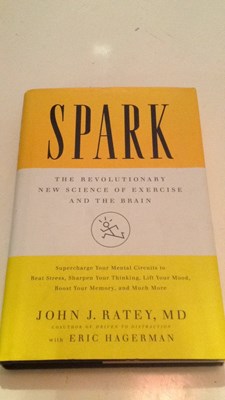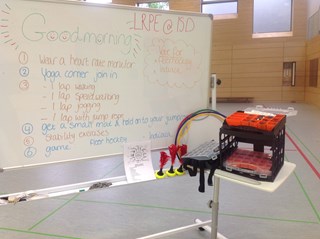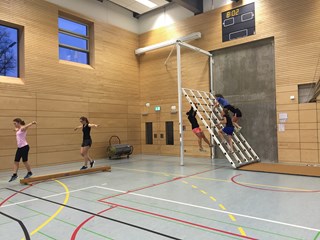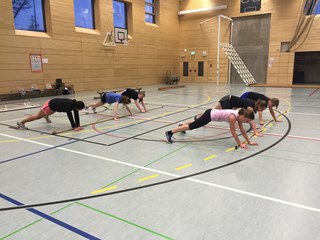Learning Readiness Physical Education at The International School of Düsseldorf
LRPE
Learning Readiness Program Physical Education (LRPE)
After learning of new research which demonstrates beneficial effects of physical activity on academic achievements we have turned an old page anew in the Physical and Health Education department. Since September 2015 we have been implementing the Learning Readiness Physical Exercise (LRPE) a new exercise program at the ISD that focuses on the mind-body connection. The offering is an early morning program that intends to make a difference between a calm, focused mind and a hurried, inattentive self; a physical exercise program that aims to affect mood, reduce stress and anxiety, and improve the attention of our students to better prepare them for the school day.
Increasing research in the area shows that physical inactivity is affecting the brain of our children, actually physically shrivelling them. For many years people have seen the mind and body as two separate entities where the body is more instrumental to the brain. However, in the past decade neuroscientists have discovered a more profound biological connection between the brain, the body and the mind, and how hormones that are released in the brain during activity have an influence on the development and restructuring of the brain itself. Physical activity affects the way we feel and think. It can help guard against stress and improves mood by increasing levels of neurotransmitters like serotonin, dopamine and norepinephrine this much was already known, but now researchers are starting to see a further impact of exercise within the brain cells; that aerobic exercise has shown to cause neurogenesis, a process that creates new brain cells. The increase and strengthening of the synapses and neural pathways within the Hippocampus improving student’s results on cognitive tasks, spatial reasoning, and memory and learning are influenced through activity. This is accomplished through the production of a protein called Brain Derived Neurotrophic Factor (BDNF). BDNF plays a key role in creating new neurons.
A study at Princeton University has also shown that, alongside the production of the protein BDNF, another neurotransmitter called Gamma Aminobutyric Acid (GABA) is released in the Hippocampus, this protein has an inhibitory effect on excitable neurons. This inhibitory effect has as benefit that it reduces anxiety and stress and helps students by cancelling out peripheral stimuli thereby improving focus and attention. Exercise sparks the release of GABA and BDNF
According to Bergland, there are 8 ways exercise can help a child to do better at school.
- Combination of motor skills and aerobic fitness improves academics
- Exercise creates more efficient white matter and brain connectivity
- Exercise before school improves focus and reduces ADHD symptoms
- Physical activity should remain playful for best results
- Boys can especially benefit from regular physical activity
- Taking “brain breaks” during class improves classroom performance
- After school exercise groups can improve cognitive function
- Resistance training and lifting weights can improve memory
ISD students enrolled in the LRPE program all wear heart rate monitors during the sessions. Best results are gained when students can keep their Heart Rate just under the anaerobic threshold between 80 and 90 percent of their maximum heart rate. While all individuals have a different cardio vascular level (aerobic fitness as discussed by Bergland) it is important to keep track on who to slow down and who to “spice up”.
All students in grades 10 and over are eligible to sign up for this program. As students get older it seems that the interest or the ability to invest in being physical active declines. Students in grades 6-10 receive already 6 periods of PHE during a 9 day cycle and are therefore less in need of activity compared to students in 11th and 12th grade who don’t have PHE on their daily school schedule. Our aims for this LRPE program are:
Get students active on Mondays and Wednesday before school starts (7:40-8:30)
Make sure the heart rate level of each participant stays in the desired training zone
Prepare the brain for learning by using brain compatible movements:
- Crossing the midline of the body (engaging both hemispheres of the brain)
- Improve visual tracking
- Develop the vestibular system (balanced body - balanced mind)
Inform participants about the benefits that physical activity has on the readiness for learning.
Inform students about how physical activity enhances the function of the brain
It is our dream to see our students take physical activity on board as part of their planning and readiness for their IB exams.
Christo Lemmers
Lieke Burghout
Work cited:
Ratey, John J. Spark: The Revolutionary New Science of Exercise and the Brain. N.p.: Little Brown, 2012. Print.
Lengel, Traci, and Mike Kuczala. The Kinesthetic Classroom: Teaching and Learning through Movement. Thousand Oaks, CA: Corwin, 2010. Print.
Bergland, Christopher. ”8 Ways Exercise Can Help Your Child Do Better in School.” Psychology Today. Psychology Today, 2 Oct. 2014. Web. 31 Jan. 2016.
Wrann, Christiane D., James P. White, John Salogiannis, Dina Lazink-Bogoslavski, Jun Wu, Di Ma, Jiandie D. Lin, Michael E. Greenberg, and Bruce M. Spiegelman. ”Exercise Induces Hippocampal BDNF through a PGC-1a/FNDC5 Pathway.” Http://www.cell.com/cell-metabolism/abstract/S1550-4131(13)00377-X. Cell Metabolism, 5 Nov. 2013. Web. 1 Feb. 2016.
Bergland, Christopher. ”The Brain Drain of Inactivity.” Psychology Today. N.p., 10 Dec. 2012. Web. 02 Feb. 2016
 IMG_0939
IMG_0939
 IMG_0962
IMG_0962
 IMG_4674
IMG_4674
 IMG_4676
IMG_4676